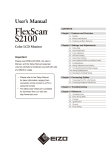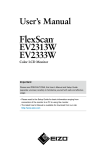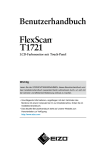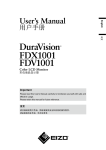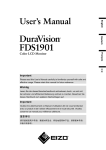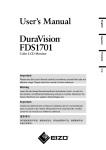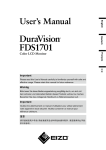Download Eizo FLEXSCAN T1721 User`s manual
Transcript
Important Please read PRECAUTIONS, this User’s Manual, and Setup Manual (separate volume) carefully to familiarize yourself with safe and effective usage. • Please refer to the Setup Manual for basic information ranging from connection of the monitor to a PC to using the monitor. • The latest User’s Manual is available for download from our web site: http://www.eizo.com As an ENERGY STAR® Partner, EIZO NANAO CORPORATION has determined that this product meets the ENERGY STAR guidelines for energy efficiency. This product has been adjusted specifically for use in the region to which it was originally shipped. If operated outside this region, the product may not perform as stated in the specifications. No part of this manual may be reproduced, stored in a retrieval system, or transmitted, in any form or by any means, electronic, mechanical, or otherwise, without the prior written permission of EIZO NANAO CORPORATION. EIZO NANAO CORPORATION is under no obligation to hold any submitted material or information confidential unless prior arrangements are made pursuant to EIZO NANAO CORPORATION’s receipt of said information. Although every effort has been made to ensure that this manual provides up-to-date information, please note that EIZO monitor specifications are subject to change without notice. Apple and Macintosh are registered trademarks of Apple Inc. Windows and Windows Vista are registered trademarks of Microsoft Corporation in the United States and other countries. ENERGY STAR is a U.S. registered mark. VESA is a registered trademark or a trademark of Video Electronics Standards Association in the United States and other countries. EIZO, EIZO Logo, FlexScan and ScreenManager are registered trademarks of EIZO NANAO CORPORATION in Japan and other countries. All other company and product names are trademarks or registered trademarks of their respective owners. 2 Notice for this monitor This product is suited to general purposes like creating documents, viewing multimedia content. This product may not be covered by warranty for uses other than those described in this manual. The specifications noted in this manual are only applicable when the following are used: · Power cords provided with the product · Signal cables specified by us Only use optional products manufactured or specified by us with this product. As it takes about 30 minutes for the performance of electrical parts to stabilize, adjust the monitor 30 minutes or more after the monitor power has been turned on. Monitors should be set to a lower brightness to reduce changes in luminosity caused by long-term use and maintain a stable display. When the screen image is changed after displaying the same image for extended periods of time, an afterimage may appear. Use the screen saver or power save function to avoid displaying the same image for extended periods of time. Periodic cleaning is recommended to keep the monitor looking new and to prolong its operation lifetime (refer to “Cleaning” (page 4)). The LCD panel is manufactured using high-precision technology. Although, missing pixels or lit pixels may appear on the LCD panel, this is not a malfunction. Percentage of effective dots: 99.9994% or higher. The backlight of the LCD panel has a fixed lifetime. When the screen becomes dark or begins to flicker, please contact your dealer. Do not scratch or press on the panel with any sharp objects, as this may result in damage to the panel. Do not attempt to brush with tissues as this may scratch the panel. When the monitor is cold and brought into a room or the room temperature goes up quickly, dew condensation may occur on the interior and exterior surfaces of the monitor. In that case, do not turn the monitor on. Instead wait until the dew condensation disappears, otherwise it may cause some damage to the monitor. (Cautions for the Use of the Touch Panel) · During touch operation Be careful of the following points. Otherwise, damage may occur to the monitor. - Do not strongly press, scratch, or poke the panel. - Do not touch the panel with hard objects such as ballpoint pens or metals. 3 Cleaning Attention • Chemicals such as alcohol and antiseptic solution may cause gloss variation, tarnishing, and fading of the cabinet or panel, and also quality deterioration of the image. • Never use any thinner, benzene, wax, and abrasive cleaner, which may damage the cabinet or panel. • Do not allow liquid to enter the clearance between the panel and the panel frame. NOTE • The optional ScreenCleaner is recommended for cleaning the cabinet and panel surface. If necessary, the stains on the cabinet and panel surface can be removed by moistening part of a soft cloth with water. To use the monitor comfortably • An excessively dark or bright screen may affect your eyes. Adjust the brightness of the monitor according to the environmental conditions. • Staring at the monitor for a long time tires your eyes. Take a 10-minute rest every hour. 4 CONTENTS Cover . ............................................................ 1 Notice for this monitor............................................... 3 CONTENTS.............................................................. 5 Chapter 1 Features and Overview...................... 6 ● To lock all operations......................................... 18 2-13 Enabling/Disabling DDC/CI communication.... 19 2-14 Setting EIZO logo display ON/OFF................ 19 2-15 Resuming the Default Setting [Reset].......... 19 ● To reset color adjustment values....................... 19 ● To reset all adjustments to the factory default 1-1 Features............................................................. 6 settings.............................................................. 19 1-2 Buttons and Indicators..................................... 7 Chapter 3 Connecting Cables........................... 20 1-3 Functions and Basic Operation....................... 8 Chapter 2 Settings and Adjustments............... 10 2-1 Setting Screen Resolution............................. 10 Compatible Resolutions/Frequencies................ 10 Setting Resolution................................................ 10 2-2 Utility Disk........................................................11 3-1 Connecting Two PCs to the Monitor............. 20 ● To switch the input signal.................................. 20 ● To set input signal selection [Input Signal]........ 20 Chapter 4 Troubleshooting................................ 21 Chapter 5 Reference.......................................... 23 ● Disk contents and software overview.................11 5-1 Attaching an Arm............................................ 23 2-3 Screen Adjustment......................................... 12 5-2 Power Saving Mode........................................ 24 Digital Input........................................................... 12 5-3 Specifications................................................. 25 Analog Input......................................................... 12 2-4 Color Adjustment............................................ 15 5-4 Glossary.......................................................... 28 ● To select the display mode (FineContrast mode).... 15 5-5 Preset Timing.................................................. 29 ● To perform advanced adjustments.................... 16 ● Adjustment items in each mode........................ 16 FCC Declaration of Conformity........................... 30 ● To set/adjust color............................................. 16 2-5 Turning off the monitor automatically [Off Timer]....................................................... 17 Hinweise zur Auswahl des richtigen Schwenkarms für Ihren Monitor...................................................... 31 2-6 Setting Adjustment Menu Position [Menu Position]............................................... 17 2-7 Setting Power Indicator ON/OFF [Power Indicator]............................................ 17 2-8 Displaying Monitor Information [Information].................................................... 17 2-9 Setting Language [Language]....................... 18 2-10 Setting On/Off for the automatic brightness adjustment function [Auto EcoView]............. 18 2-11 Displaying the level of power saving by EcoView Index................................................. 18 2-12 Locking Buttons............................................. 18 ● To lock adjustments/settings in the Adjustment menu................................................................. 18 CONTENTS 5 Chapter 1 Features and Overview Thank you very much for choosing an EIZO color LCD monitor. 1-1 Features • 17-inch screen • Applicable to the resolution of 1280 × 1024 • Touch Panel provided – Surface Acoustic Wave technology A highly durable and transmissible touch panel with accurate touch positions making operations using gloves possible. • Stereo speakers • Power saving function Suppressing the power consumption*1 reduces the carbon dioxide emissions. This product is equipped with various power saving functions. – Auto EcoView function The sensor on the front side of the monitor detects the environmental brightness to adjust the screen brightness automatically and comfortably. Excessively high brightness may lead a damage to the natural environment as well as to your eyes. Suppressing the excessively high brightness will be helpful to reduce the power consumption and the damage to your eyes. 2-10 “Setting On/Off for the automatic brightness adjustment function [Auto EcoView]” (page 18) – EcoView Index function This indicator shows the power saving ratio, power reduction and CO2 reduction as a result of the brightness of the monitor. You can realize the power consumption reduction by taking consideration in the ratio of power saving. 2-11 “Displaying the level of power saving by EcoView Index” (page 18) • FineContrast function to allow the best mode for screen display ● “To select the display mode (FineContrast mode)” (page 15) • The ArcSwing 2 Stand enables to adjust the monitor height and monitor angle freely 6 Chapter 1 Overview and Features NOTE • The stand of the unit can be replaced with an arm or another stand. (Refer to “5-1 Attaching an Arm” on page 23.) 1-2 Buttons and Indicators Adjustment menu (*ScreenManager ® ) Buttons 1. 2. 3. 4. 5. 6. 7. 8. Sensor (Auto EcoView) EcoView button Volume control button Input signal selection button Control buttons (Left, Right) Enter button Power button Power indicator Indicator status Operation status Blue The screen is displayed Orange Power saving Off Power off * ScreenManager ® is an EIZO’s nickname of the Adjustment menu. NOTE • While the screen is displayed, the blue power indicator that is lighting blue can be turned off (see “To turn off the Power indicator while a screen is displayed [Power Indicator]” on page 17). Chapter 1 Overview and Features 7 1-3 Functions and Basic Operation To adjust the screen and color Main menu (Refer to page 9 for operation) (for analog signal input only) Adjustment 1 Screen (Automatic Adjustment) • The Adjustment menu and the EcoView menu cannot be displayed at the same time. EcoView menu ● To adjust flickering and position [Screen]……………………………… see page 12 ● To adjust color gradation automatically [Range]……………………………… see page 14 Adjustment 2 Screen (Advanced Adjustment) Page 13 ● Setting On/Off for the automatic brightness adjustment function [Auto EcoView]…………………………… see page 18 . 1 Press or 2 Change “On” and “Off” with . ● Displaying the level of power saving by EcoView Index……………………………………… see page 18 [Adjustment menu] ● To eliminate vertical bars [Clock*]…… see page 13 ● To remove flickering or blurring [Phase*]………………………………… see page 13 ● To correct screen position [Hor. Position*]………………………… see page 14 [Ver. Position*]………………………… see page 14 ● To modify blurred characters/lines [Smoothing]… ………………………… see page 14 Press to display the level of power saving mode. [At analog signal input] * Brightness Adjustment Press or 1 Press 2 Press [At digital signal input] Items marked with * can be adjusted with analog input. Color Adjustment Page 15 to adjust brightness. Volume Adjustment 8 Page 12 ● To select the display mode (FineContrast mode) … ……………………………………… see page 15 ● “Brightness,” “Contrast,” “Temperature,” “Gamma,” and “Gain” can be set for each mode (Custom/sRGB/Text). Settable functions vary with the display mode. . or to adjust volume. Chapter 1 Overview and Features Resumption of Default Setting ● To reset color adjustment values [Reset]… ……………………………… see page 19 To make useful settings/adjustments Adjustment menu (Refer to below for operation) Information Page 17 ● Displaying monitor information [Information] Language Page 18 ● Setting Language [Language] Setting Input Signal Selection ● To set input signal selection [Input Signal]… ……………………… see page 20 Off Timer Setting ● Turning off the monitor automatically [Off Timer]……………………………… see page 17 Setting Adjustment Menu Position ● Setting Adjustment Menu Position [Menu Position]… …………………… see page 17 Power Indicator Setting ● Setting Power Indicator ON/OFF [Power Indicator]……………………… see page 17 ● Locking Buttons [Adjustment Lock] … …………………………………… see page 18 ● Enabling/Disabling DDC/CI communication [DDC/CI]… ………………………… see page 19 ● Setting EIZO logo display ON/OFF…see page 19 Resumption of Default Setting ● To reset all adjustments to the factory default settings [Reset]… …………………… see page 19 Basic operation of Adjustment menu [Displaying Adjustment menu and selecting function] (1) Press . The main menu appears. (2) Select a function with or , and press . The sub menu appears. (3) Select a function with or , and press . The adjustment/setting menu appears. (4) Adjust the selected item with or , and press . The setting is saved. [Exiting Adjustment menu] (1) Choose <Return> from the sub menu and press (2) Choose <Exit> from the main menu and press . . NOTE • The Adjustment menu can also be exited by pressing twice quickly. Chapter 1 Overview and Features 9 Chapter 2 Settings and Adjustments 2-1 Setting Screen Resolution Compatible Resolutions/Frequencies For details on compatible resolutions, refer to “Compatible Resolutions/Frequencies” in the Setup Manual. Setting Resolution When you connect the monitor to the PC and find that the resolution is improper, or when you want to change the resolution, follow the procedure below. ● Windows 7 1.Right-click the mouse anywhere on the desktop except for icons. 2.From the displayed menu, click “Screen resolution”. 3.On the “Screen Resolution” dialog box, select the monitor. 4.Click “Resolution” to select the desired resolution. 5.Click the “OK” button. 6.When a confirmation dialog box is displayed, click [Keep changes]. ● Windows Vista 1.Right-click the mouse anywhere on the desktop except for icons. 2.From the displayed menu, click “Personalize”. 3.On the “Personalization” window, click “Display Settings”. 4.On the “Display Settings” dialog, select the “Monitor” tab and select desired resolution in the “Resolution” field. 5.Click the [OK] button. 6.When a confirmation dialog is displayed, click [Yes]. ● Windows XP 1.Right-click the mouse anywhere on the desktop except for icons. 2.From the displayed menu, click “Properties”. 3.When the “Display Properties” dialog is displayed, click the “Settings” tab and select desired resolution for “Screen resolution” under “Display”. 4.Click the [OK] button to close the dialog. 10 Chapter 2 Settings and Adjustments 2-2 Utility Disk An “EIZO LCD Utility Disk” (CD-ROM) is supplied with the monitor. The following table shows the disk contents and the overview of the application software programs. ● Disk contents and software overview The disk includes a touch panel driver and User's Manual. Refer to “Readme.txt” on the disk for software startup procedures or file access procedures. Item Overview OS A “Readme.txt” file Screen adjustment pattern files Used when adjusting the image of the analog signal input manually. Touch Panel Driver Driver for touch panel Windows 7/Vista/XP User’s Manual of this monitor (PDF file) Installation Guide for Touch Panel Driver (PDF file) Chapter 2 Settings and Adjustments 11 2-3 Screen Adjustment Digital Input When digital signals are input, images are displayed correctly based on the preset data of the monitor, but if characters and/or lines appear blurred, go to step 6 “To modify blurred characters/lines [Smoothing]”. When performing more advanced adjustment, see “2-4 Color Adjustment” (page 15) and subsequent pages. Analog Input Attention The monitor screen adjustment is used to suppress flickering of the screen or adjust screen position and screen size correctly according to the PC to be used. To use the monitor comfortably, adjust the screen when the monitor is set up for the first time or when the settings of the PC in use are updated. • Wait 30 minutes or more from monitor power on before starting adjustments. (Allow the monitor to warm up for at least 30 minutes before making adjustments.) The auto adjustment function works when filling/satisfying all of the following conditions • When a signal is input into the monitor for the first time or when the resolution or Vertical/Horizontal Frequency not displayed before is set • When signals with the vertical resolution over 480 are input If the screen is not displayed correctly even after performing the auto adjustment, perform the screen adjustments according to the procedures on the following pages to use the monitor comfortably. [Adjustment Procedure] 1 Perform the auto adjustment. Attention ● To adjust flickering, screen position, and screen size automatically [Screen] (1) Choose <Screen> from the <Auto Adjustment> menu, and press . The <Screen> menu appears. (2) Select “Execute” with or , and press . Flickering, screen position, and screen size are corrected by the autoadjustment function. If the screen is not displayed correctly even after adjusting in step 1 above, perform the adjustments according to the procedures on the following pages. When the screen is displayed correctly, go to step 5 “To adjust color gradation automatically [Range]”. 2 Prepare the display pattern for the analog display adjustment. Load the “EIZO LCD Utility Disk” to your PC, and then open the “Screen adjustment pattern files”. 12 • This function works correctly when an image is fully displayed over the display area. It does not work properly when an image is displayed only on a part of the screen (DOS prompt window, for example) or when a black background (wallpaper, etc.) is in use. • This function does not work correctly with some graphics boards. Chapter 2 Settings and Adjustments NOTE • For details and instructions on opening the “Screen adjustment pattern files”, refer to the “Readme.txt” file. 3 Perform the auto adjustment again with the analog screen adjustment pattern displayed. ● To adjust flickering, screen position, and screen size automatically [Screen] (1) Display Pattern 1 of the “Screen adjustment pattern files” in full screen on the monitor. (2) Choose <Screen> from the <Auto Adjustment> menu, and press . The <Screen> menu appears. (3) Select “Execute” with or , and press . Flickering, screen position, and screen size are corrected by the autoadjustment function. If the screen is not displayed correctly even after adjusting in step 3 above, perform the adjustments according to the procedures on the following pages. When the screen is displayed correctly, go to step 5 “To adjust color gradation automatically [Range]”. 4 Perform advanced adjustments for the following using the <Screen> menu of the Adjustment menu. Adjust the clock, phase and position, in this order. ● To eliminate vertical bars [Clock] (1) Choose <Clock> from the <Screen> menu, and press The <Clock> menu appears. (2) Adjust the clock with or The adjustment is completed. , and press . . ● To remove flickering or blurring [Phase] Adjustable range: 0 to 63 Attention (1) Choose <Phase> from the <Screen> menu, and press The <Phase> menu appears. (2) Adjust the phase with or The adjustment is completed. , and press NOTE • Press the control button slowly so as not to miss the adjustment point. • When blurring, flickering or bars appear on the screen after adjustment, proceed to [Phase] to remove flickering or blurring. . . • Flickering or blurring may not be eliminated depending on your PC or graphics board. NOTE • When vertical bars appear on the screen after adjustment, go back to “To eliminate vertical bars [Clock].” (Clock → Phase → Position) Chapter 2 Settings and Adjustments 13 ● To correct screen position [Hor. Position], [Ver. Position] NOTE (1) Choose <Hor. Position> and or <Ver. Position> from the <Screen> . menu, and press The <Hor. Position> or <Ver. Position> menu appears. (2) Adjust the position with or to display the image properly in the display area of the monitor. The adjustment is completed. 5 Adjust the color gradation. ● To adjust color gradation automatically [Range] Every color gradation (0 to 255) can be displayed by adjusting the signal output level. (1) Display Pattern 2 in full screen on the monitor using the “Screen adjustment pattern files”. (2) Choose <Range> from the <Auto Adjustment> menu, and press . (3) Select “Execute” with or , and press . The output range is adjusted automatically. (4) Close the Pattern 2. 6 Modify blurred characters or lines. ● To modify blurred characters/lines [Smoothing] When a image is displayed with a resolution other than the recommendation, the characters or lines of the displayed image may be blurred. Adjustable range: 1 to 5 . (1) Choose <Smoothing> from the <Screen> menu, and press The <Smoothing> menu appears. (2) Adjust the characters/lines with The adjustment is completed. 14 Chapter 2 Settings and Adjustments or , and press . • Since the number of pixels and the pixel positions are fixed on the LCD monitor, only one position is provided to display images correctly. The position adjustment is made to shiftn an image to the correct position. 2-4 Color Adjustment ● To select the display mode (FineContrast mode) This function allows you to select the best display mode for monitor brightness, etc. FineContrast mode Mode Purpose Custom Available for making desired setting. EyeCare Allows the brightness to be set lower than possible with other modes. sRGB Suitable for color matching with sRGB compatible peripherals. Text Suitable for displaying texts for word processing or spreadsheets. (1) Choose <Color> from the Adjustment menu, and press . (2) Choose <Color Mode> from the <Color> menu, and press The <Color Mode> menu appears. (3) Select the mode with The setting completes. or , and press . . Chapter 2 Settings and Adjustments 15 ● To perform advanced adjustments Attention Independent setting and saving of color adjustment are available for each FineContrast mode. ● Adjustment items in each mode According to the FineContrast mode selected, the adjustable function differs. √ : Adjustment available −: Invalid for adjustment Icon Function Custom EyeCare sRGB Text Brightness √ √ √ √ Contrast √ − − √ Temperature √ √ − √ Gain √ √ − − Reset √ √ √ √ Menu Brightness FineContrast mode Description Adjustment range To adjust the full screen brightness as desired 0 to 100% NOTE • You can also adjust the brightness by pressing or button while the adjustment menu is not displayed. • Press Contrast after adjustment. To adjust the contrast of the 0 to 100% image Temperature To select a color temperature Off, 5000K, 6500K, 9300K NOTE • Setting the value to “Off” presents the natural color of the panel. • The values shown in the Kelvin (K) are available only as reference. Gain To adjust red, green, and 0 to 100% blue to a desired color tone Adjust the respective brightness of respectively red/green/blue to make a desired color tone. Display an image with white or gray background for adjustment. NOTE • Values shown in percentage are available only as reference. • When using the <Gain> setting, the <Temperature> setting is set to “Off”. Reset To reset the color settings of the selected FineContrast mode to the default settings ● To set/adjust color (1) Choose <Color> from the Adjustment menu, and press . (2) Select a desired function from the <Color> menu, and press The selected function menu appears. (3) Adjust the selected item with or The adjustment is completed. 16 Chapter 2 Settings and Adjustments , and press . . • Wait 30 minutes or more from monitor power on before starting adjustments. • Perform the range adjustment first when adjusting color for analog input signals. (Refer to “To adjust color gradation automatically” on page 14.) • The same image may be seen in different colors on multiple monitors due to their monitor-specific characteristics. Make fine color adjustment visually when matching colors on multiple monitors. 2-5 Turning off the monitor automatically [Off Timer] This function allows you to switch the setting to turn off the monitor automatically after a specified time has passed at the power saving mode. Adjustable range: Disable, Enable (0, 1, 2, 3, 5, 10, 15, 20, 25, 30, 45 min, 1-5h) (1) Choose <Others> from the Adjustment menu, and press (2) Choose <Off Timer> from the <Others> menu, and press . . The <Off Timer> menu appears. (3) Select “Enable” or “Disable” with or . When selecting “Enable”, set a monitor Off time with (4) Press . or . The setting is completed. 2-6 Setting Adjustment Menu Position [Menu Position] Adjust the menu position using the following procedure. . (1) Choose <Others> from the Adjustment menu, and press (2) Choose <Menu Position> from the <Others> menu, and press . The <Menu Position> menu appears. (3) Select a menu position with The setting is completed. or , and press . 2-7 Setting Power Indicator ON/OFF [Power Indicator] This function allows you to set the power indicator (blue) ON/OFF in the monitor ON condition. . (1) Choose <Others> from the Adjustment menu, and press (2) Choose <Power Indicator> from the <Others> menu, and press . The <Power Indicator> menu appears. (3) Select “Enable” or “Disable” with or , and press . The setting is completed. 2-8 Displaying Monitor Information [Information] NOTE This function allows you to display the input signal status, current resolution and model name. Information 1/3 : I nput signal status, resolution and H/V frequency Information 2/3 : E nable/Disable setting for DDC/CI odel name, serial number and usage time Information 3/3 : M (1) Choose <Information> from the Adjustment menu, and press • The usage time is not always “0” when you purchase the monitor due to factory inspection. . The <Information> menu appears. (2) Then, press to check settings, etc. Chapter 2 Settings and Adjustments 17 2-9 Setting Language [Language] This function allows you to select a language for the adjustment menu or displaying message. Selectable languages English/German/French/Spanish/Italian/Swedish/Simplified Chinese/ Traditional Chinese/Japanese (1) Choose <Language> menu from the Adjustment menu, and press . The <Language> menu appears. (2) Choose a language with The setting is completed. or , and press . 2-10 Setting On/Off for the automatic brightness adjustment function [Auto EcoView] The sensor on the front side of the monitor detects the environmental brightness to adjust the screen brightness automatically and comfortably by using the Auto EcoView function. (1) Press . NOTE • Be careful not to block the sensor on the lower side of the monitor when using the Auto EcoView function. The <Auto EcoView> menu appears. (2) Select “On” or “Off” with The setting is completed. or , and press . 2-11 Displaying the level of power saving by EcoView Index This indicator shows the power saving ratio, power reduction and CO2 reduction as a result of the brightness of the monitor. (1) Press . The EcoView Index menu appears. The power saving ratio comes to high as the indicator level meter lights towards right. 2-12 Locking Buttons This function allows you to lock to prevent changing the adjusted/set status. ● To lock adjustments/settings in the Adjustment menu (1) Press (2) Press to turn off the monitor. holding down to turn on the monitor. You can toggle between Lock and Unlock by performing steps 1 and 2. ● To lock all operations (1) Holding down, press for five seconds while the screen is displayed. You can toggle between Lock and Unlock by performing this step. 18 Chapter 2 Settings and Adjustments NOTE Power reduction: the backlight’s reduction of electricity consumption as a result of the adjusted brightness value CO2 reduction: converted from the “Power reduction” value, this is an estimate of the quantity of CO2 emissions reduced when using the monitor for 1 hour. *The numeric value is a result of a calculation based on a default value (0.000555 t -CO2/kWh) determined by a ministerial ordinance (2006, Ministry of Economy, Trade and Industry, Ministry of Environment, civil code article 3) and may differ depending on country and year. 2-13 Enabling/Disabling DDC/CI communication NOTE • You can check the DDC/CI setting in the <Information> menu. This function allows you to enable/disable the DDC/CI communication. (1) Press to turn off the monitor. (2) Press holding down to turn on the monitor. You can toggle between Enable and Disable by performing steps 1 and 2. 2-14 Setting EIZO logo display ON/OFF The EIZO logo appears on the display when turning on the monitor. This function allows you to display, or not, the EIZO logo. (1) Press to turn off the monitor. holding down to turn on the monitor. (2) Press The EIZO logo display setting is toggled by performing the operation in steps 1 and 2. 2-15 Resuming the Default Setting [Reset] Attention There are two types of Reset. One is to reset the color adjustment only to the default settings, and the other is to reset all the settings to the default settings. • After resetting, you cannot undo the operation. ● To reset color adjustment values Only the adjustment values in the current FineContrast mode will revert to the default settings (factory settings). (1) Choose <Color> from the Adjustment menu, and press (2) Choose <Reset> from the <Color> menu and press . (3) Select <Reset> with or , and press . . The color adjustment values revert to the default settings. ● To reset all adjustments to the factory default settings Reset all adjustments to the factory default settings. (1) Choose <Others> from the Adjustment menu, and press (2) Choose <Reset> from the <Others> menu, and press . (3) Select <Reset> with or , and press . . NOTE • For default settings, refer to “Main default settings (factory settings)” on page 26. All setting values revert to the default settings. Chapter 2 Settings and Adjustments 19 Chapter 3 Connecting Cables 3-1 Connecting Two PCs to the Monitor Two PCs can be connected to the monitor through the DVI-D and the D-Sub mini 15 pin connector on the back of the monitor. Connection examples D-sub mini DVI-D connector 15-pin Connector Attention • The touch panel monitor is designed to use connecting to one PC. If connecting two PCs, connect the touch panel monitor to one PC only (touch operation side) with a USB cable (MD-C93) or RC-232C cable (FD-C38-K). • Do not use the Dual Link cable. To PC 2 To PC 1 DVI connector D-sub mini 15-pin Connector Signal cable (Digital) FD-C39 (supplied) Signal cable (Analog) MD-C87 (supplied) ● To switch the input signal Input Signal Selection button Switch the input signal with . Input signal switches each time is pressed. When the signal is switched, the active signal type (Analog or Digital) appears at the top right corner of the screen for three seconds. ● To set input signal selection [Input Signal] Setting Function NOTE Auto When a PC is turned off or enters the powersaving mode, the monitor automatically displays another signal. Manual The monitor detects only the PC’s signals currently displaying automatically. Select an active input signal with . [Procedure] . (1) Choose <Others> from the Adjustment menu, and press (2) Choose <Input Signal> from the <Others> menu, and press The <Input Signal> menu appears. (3) Select “Auto” or “Manual” with The setting is completed. 20 Chapter 3 Connecting Cables or , and press . . • When “Auto” is selected for <Input Signal>, the monitor’s power-saving function works only when the two PCs are in the power-saving mode. Chapter 4 Troubleshooting If a problem still remains after applying the suggested remedies, contact your local dealer. • No-picture problems → See No.1 - No.2. • Imaging problems → See No.3 - No.11. • Other problems → See No.12 - No.13. • Touch panel problems → See No.14 - No.15. Problems 1. No picture • Power indicator does not light. Possible cause and remedy • Check whether the power cord is connected correctly. • Press . • Power indicator is lighting blue. • Set each adjusting value in <Brightness>, <Contrast> and <Gain> to higher level. (page 16) • Power indicator is lighting orange. • • • • 2. The message below appears. Switch the input signal with . Operate the mouse or keyboard. Touch the panel surface. Turn on the PC. This message appears when the signal is not input correctly even when the monitor functions properly. • This message appears when no signal is input. • The message shown left may appear, because some PCs do not output the signal soon after power-on. • Check whether the PC is turned on. • Check whether the signal cable is connected properly. • Switch the input signal with . • The message below shows that the input signal is out of the specified frequency range. (Such signal frequency is displayed in red.) Example: • Select an appropriate display mode using the graphics board’s utility software. Refer to the manual of the graphics board for details. fD:Dot Clock (Displayed only when the digital signal inputs) fH:Horizontal Frequency fV:Vertical Frequency 3. Display position is incorrect. • Adjust image position so that it is displayed properly within the display area using the <Hor.Position> and <Ver.Position> adjustment. • If the problem persists, use the graphics board’s utility software if available to change the display position. 4. Vertical bars appear on the screen or a part of the image is flickering. • Adjust using <Clock>. (page 13) 5. Whole screen is flickering or blurring. • Adjust using <Phase>. (page 13) 6. Characters are blurred. • Adjust using <Smoothing>. (page 14) Chapter 4 Troubleshooting 21 Problems Possible cause and remedy 7. The screen is too bright or too dark. • Adjust using <Brightness> or <Contrast>. (The LCD monitor backlight has a fixed life span. When the screen becomes dark or begins to flicker, contact your local dealer.) • Turn on the Auto EcoView function. (see page 18) The monitor detects the environmental brightness to adjust the screen brightness automatically. 8. Afterimages appear. • Afterimages are particular to LCD monitors. Avoid displaying the same image for a long time. • Use the screen saver or power save function to avoid displaying the same image for extended periods of time. 9. Green/red/blue/white dots or defective dots remain • This is due to LCD panel characteristics and is not a on the screen. failure. 10. The display image is appeared in lengthwise. • Check whether the kind of cables connected with the monitor and the PC. (Connect the monitor and cables correctly by referring to “Connecting Cables” in Setup Manual (page 3).) 11. The adjustment menu does not appear. • Check whether the operation lock function works. (page 18) 12. The auto-adjustment function does not work correctly. • This function does not work when digital signal is input. • This function works correctly when an image is fully displayed over the display area. It does not work properly when an image is displayed only on a part of the screen (DOS prompt window, for example) or when a black background (wallpaper, etc.) is in use. This function does not work correctly with some graphics boards. 13. No audio output • Check whether volume is set to “0”. • Check the settings of the PC and the audio playback software. Touch panel problems Problems Possible cause and remedy 14. Cursor position is not correct. / Cursor jumps. • Turn off and on the monitor. If the symptom is not improved, perform the calibration on the monitor. • Touch with one finger only. 15. No touch sound. • The touch sound may not be output from the external line out of the PC depending on the hardware configuration. • Under Windows 7, touch sound is only output through the audio output terminal of the PC. To hear touch sound, connect speakers. 22 Chapter 4 Troubleshooting Chapter 5 Reference 5-1 Attaching an Arm The stand can be removed and replaced with an arm (or another stand) to be attached to the monitor. [Attaching] 1 Lay the LCD monitor on a soft cloth spread over on a stable surface with the panel surface facing down. 2 Remove the stand. (Prepare a screwdriver.) Unscrew the four screws securing the unit and the stand with the screwdriver. 3 Attach the monitor to the arm or stand. Secure the monitor to the arm or stand using the screws specified in the user’s manual of the arm or stand. Attention • When attaching an arm or stand, follow the instructions of their user’s manual. • When using another manufacturer’s arm or stand, confirm the following in advance and select one conforming to the VESA standard. Use M4 × 12 mm screws supplied with the monitor. – Clearance between the screw holes: 100 mm × 100 mm –Thickness of plate: 2.6 mm –Strong enough to support weight of the monitor unit (except the stand) and attachments such as cables. • When using an arm or stand, attach it to meet the following tilt angles of the monitor. –Up 60 degrees, down 45 degrees (horizontal display) • Connect the cables after attaching an arm or a stand. Chapter 5 Reference 23 5-2 Power Saving Mode Analog input This monitor complies with the VESA DPMS standard. [Power Saving System] PC Operating Power saving Power Indicator Monitor STAND-BY SUSPENDED OFF Operating Blue Power saving Orange Attention • Unplugging the power cord completely shuts off power supply to the monitor. • Power consumption varies even when the stereo mini jack cable is connected. Digital input This monitor complies with the DVI DMPM standard. [Power Saving System] The monitor enters the power saving mode in five seconds in connection with the PC setting. PC Monitor Power Indicator Operating Operating Blue Power saving Power saving Orange [Resumption Procedure] • Touch the panel surface, or operate the keyboard or the mouse. 24 Chapter 5 Reference Attention • Depending on the hardware configuration of the PC, the monitor may not be resumed from the standby status by the touch operation. • If the PC does not resume from the standby status, even when the mouse or the keyboard is operated, press the power button of the PC. 5-3 Specifications LCD Panel 17-inch (43 cm) TFT color LCD with anti-glare hard coating Viewing angle: Horizontal 160°, Vertical 160° (CR: 10 or more) Dot Pitch 0.264 mm Horizontal Scan Frequency Analog: 24.8 - 80 kHz Digital: 31 - 64 kHz Vertical Scan Frequency Analog: 50 - 75 Hz (Non-interlace) Digital: 59 - 61 Hz, (VGA Text: 69 - 71 Hz) (Non-interlace) Resolution 1280 dots × 1024 lines Max. Dot Clock Analog: 135 MHz Digital: 108 MHz Max. Display Colors Approx. 16.77 million colors Display Area (H × V) 337.9 mm × 270.3 mm Touch Panel OS Microsoft Windows 7 (32 bit/64 bit) Microsoft Windows Vista Service Pack 2 (32 bit) Microsoft Windows XP Service Pack 3 (32 bit) (Not compatible with Mac OS) Communication protocol USB Detective method Surface Acoustic Wave technology Power Supply Power Consumption 100 - 120 VAC ±10% 50/60 Hz, 0.6 A 200 - 240 VAC ±10% 50/60 Hz, 0.35 A Screen Display On 34W or less (with USB load, Speaker working) 31W or less (without USB load, Speaker not working) Power saving mode 2.6W or less (for D-Sub single signal input, with USB load, when stereo mini jack cable is not connected) 0.7W or less (for D-Sub single signal input, without USB load, when stereo mini jack cable is not connected) Power button Off 0.6W or less Input Signal Connectors DVI-D connector, D-sub mini 15-pin connector Analog Input Signal (Sync) Separate, TTL, Positive/Negative Analog Input Signal (Video) Analog, Positive (0.7Vp-p/75Ω) Digital Signal Transmission System TMDS (Single Link) Video Signal Memory Analog Signal: 26 (preset: 15) Audio output Speaker output: 0.5 W + 0.5 W (8 Ω, THD: 10% or less) Line input Input impedance 39 kΩ (typ.) Input level: 2.0 Vrms (Max.) Plug & Play VESA DDC 2B/EDID structure 1.3 Dimensions (Width) × (Height) × (Depth) Main unit 380 mm × 280 - 415 mm × 200 - 335 mm (15.0” × 11.0” - 16.3” × 7.9” - 13.2”) Main unit (without stand) 380 mm × 353 mm × 58 mm (15.0” × 13.9” × 2.28”) Mass Main unit Approx. 7.0 kg (15.4 lbs.) Main unit (without stand) Approx. 5.2 kg (11.5 lbs.) Movable range Environmental Conditions Tilt: 60° Up, -5° Down Adjustable height: 104 mm (4.1 inch) Temperature Operating: 0 °C - 35 °C Transportation/Storage: –20 °C - 60 °C Humidity Operating: 20% - 80% R.H. (no condensation) Transportation/Storage: 10% - 80% R.H. (no condensation) Pressure Operating: 700 to 1,060 hPa Transportation/Storage: 200 to 1,060 hPa Chapter 5 Reference 25 Main default settings (factory settings) Auto EcoView On Smoothing 3 FineContrast Mode Custom Input Signal Auto Off Timer Disable Language English Outside Dimensions unit : mm (inch) 346.2(13.6) 322.2(12.7) TILT 380(15.0) 338.4(13.3) 20.8(0.82) 25° 140(5.5) 58(2.28) 35.5 (1.4) 100(3.9) 140(5.5) Φ200(7.9) 26 Chapter 5 Reference 285(11.2) 280(11.0) 100(3.9) 143(5.6) (1.34~2.48) 14.5(0.57) 106.5(4.2) 34~63 56.9 (2.24) 256(10.1) 272.2(10.7) 353(13.9) 280~415(11.0~16.3) 110(4.3) 23.9 (0.94) 20.8 (0.82) 5° 310(12.2) 325(12.8) Connector Pin Assignment • DVI-D connector 1 2 3 4 5 6 7 8 9 10 11 12 13 14 15 16 17 18 19 20 21 22 23 24 Pin No. Signal Pin No. Signal Pin No. Signal 1 TMDS Data 2- 9 TMDS Data1- 17 TMDS Data 0- 2 TMDS Data 2+ 10 TMDS Data1+ 18 TMDS Data 0+ 3 TMDS Data2/4 Shield 11 TMDS Data1/3 Shield 19 TMDS Data 0/5 Shield 4 NC* 12 NC* 20 NC* 5 NC* 13 NC* 21 NC* 6 DDC Clock (SCL) 14 +5V Power 22 TMDS Clock shield 7 DDC Data (SDA) 15 Ground (return for +5V, Hsync and Vsync) 23 TMDS Clock+ 8 NC* 16 Hot Plug Detect 24 TMDS Clock(NC*: No Connection) • D-sub mini 15-pin connector 3 4 5 9 10 15 1 2 8 7 6 14 13 12 11 Pin No. Signal Pin No. Signal Pin No. Signal 1 Red 6 Red ground 11 NC* 2 Green 7 Green ground 12 Data (SDA) 3 Blue 8 Blue ground 13 H. Sync 4 NC* 9 NC* 14 V. Sync 5 Ground 10 Ground 15 Clock (SCL) (NC*: No Connection) • USB port Upstream Contact No. Signal Remarks 1 VCC Cable power 2 – Data Serial data 3 + Data Serial data 4 Ground Cable ground Option List Cleaning Kit EIZO ScreenCleaner Touch Panel Pointer TP1 For the latest information about the accessories, refer to our web site. http://www.eizo.com Chapter 5 Reference 27 5-4 Glossary Clock The analog input monitor needs to reproduce a clock of the same frequency as the dot clock of the graphics system in use, when the analog input signal is converted to a digital signal for image display. This is called clock adjustment. If the clock pulse is not set correctly, some vertical bars appear on the screen. DVI (Digital Visual Interface) DVI is a digital interface standard. DVI allows direct transmission of the PC’s digital data without loss. This adopts the TMDS transmission system and DVI connectors. There are two types of DVI connectors. One is a DVI-D connector for digital signal input only. The other is a DVI-I connector for both digital and analog signal inputs. DVI DMPM (DVI Digital Monitor Power Management) DVI DMPM is a digital interface power-saving function. The “Monitor ON (operating mode)” and “Active Off (power-saving mode)” are indispensable for DVI DMPM as the monitor’s power mode. Gain This is used to adjust each color parameter for red, green and blue. An LCD monitor displays the color by the light passing through the panel color filter. Red, green and blue are the three primary colors. All the colors on the screen are displayed by combining these three colors. The color tone can be changed by adjusting the light intensity (volume) passing through each color’s filter. Gamma Generally, the monitor brightness varies nonlinearly with the input signal level, which is called “Gamma Characteristic”. A small gamma value produces a low-contrast image, while a large gamma value produces a high-contrast image. Phase Phase means the sampling timing to convert the analog input signal to a digital signal. Phase adjustment is made to adjust the timing. It is recommended that phase adjustment be made after the clock is adjusted correctly. Range Adjustment Range adjustment controls the signal output levels to display every color gradation. It is recommended that range adjustment be made before color adjustment. Resolution The LCD panel consists of numerous pixels of specified size, which are illuminated to form images. The display panel of this monitor consists of 1280 horizontal pixels and 1024 vertical pixels. At a resolution of 1280 x 1024, images are displayed as a full screen (1:1). sRGB (Standard RGB) International standard for “color reproduction and color space” among peripheral devices (such as monitors, printers, digital cameras, scanners). sRGB allows Internet users to closely match colors as a simple color matching means for the Internet use. Temperature Color temperature is a method to measure the white color tone, generally indicated in degrees Kelvin. The screen becomes reddish at a low temperature, and bluish at a high temperature, like the flame temperature. 5000K: Slightly reddish white 6500K: Warm white like paper white 9300K: Slightly bluish white TMDS (Transition Minimized Differential Signaling) A signal transmission system for digital interface. VESA DPMS (Video Electronics Standards Association - Display Power Management Signaling) VESA provides the standardization of signals from PC (graphics board) for power saving of PC monitors. DPMS defines the signal status between PC and monitor. 28 Chapter 5 Reference 5-5 Preset Timing The following table shows factory preset video timing (for analog signal only). Mode Dot clock VGA 640×480@60Hz 25.2 MHz VGA TEXT 720×400@70Hz 28.3 MHz VESA 640×480@72Hz 31.5 MHz VESA 640×480@75Hz 31.5 MHz VESA 800×600@56Hz 36.0 MHz VESA 800×600@60Hz 40.0 MHz VESA 800×600@72Hz 50.0 MHz VESA 800×600@75Hz 49.5 MHz VESA 1024×768@60Hz 65.0 MHz VESA 1024×768@70Hz 75.0 MHz VESA 1024×768@75Hz 78.8 MHz VESA 1152×864@75Hz 108.0 MHz VESA 1280×960@60Hz 108.0 MHz VESA 1280×1024@60Hz 108.0 MHz VESA 1280×1024@75Hz 135.0 MHz Horizontal Vertical Horizontal Vertical Horizontal Vertical Horizontal Vertical Horizontal Vertical Horizontal Vertical Horizontal Vertical Horizontal Vertical Horizontal Vertical Horizontal Vertical Horizontal Vertical Horizontal Vertical Horizontal Vertical Horizontal Vertical Horizontal Vertical Frequency Horizontal: kHz Vertical: Hz 31.47 59.94 31.47 70.09 37.86 72.81 37.50 75.00 35.16 56.25 37.88 60.32 48.08 72.19 46.88 75.00 48.36 60.00 56.48 70.07 60.02 75.03 67.50 75.00 60.00 60.00 63.98 60.02 79.98 75.03 Polarity Negative Negative Negative Positive Negative Negative Negative Negative Positive Positive Positive Positive Positive Positive Positive Positive Negative Negative Negative Negative Positive Positive Positive Positive Positive Positive Positive Positive Positive Positive Attention • Display position may be deviated depending on the PC connected, which may require screen adjustment using Adjustment menu. • If a signal other than those listed in the table is input, adjust the screen using the Adjustment menu. However, screen display may still be incorrect even after the adjustment. • When interlace signals are used, the screen cannot be displayed correctly even after screen adjustment using the Adjustment menu. Chapter 5 Reference 29 For U.S.A. , Canada, etc. (rated 100-120 Vac) Only FCC Declaration of Conformity We, the Responsible Party EIZO NANAO TECHNOLOGIES INC. 5710 Warland Drive, Cypress, CA 90630 Phone: (562) 431-5011 declare that the product Trade name: EIZO Model: FlexScan T1721 is in conformity with Part 15 of the FCC Rules. Operation of this product is subject to the following two conditions: (1) this device may not cause harmful interference, and (2) this device must accept any interference received, including interference that may cause undesired operation. This equipment has been tested and found to comply with the limits for a Class B digital device, pursuant to Part 15 of the FCC Rules. These limits are designed to provide reasonable protection against harmful interference in a residential installation. This equipment generates, uses, and can radiate radio frequency energy and, if not installed and used in accordance with the instructions, may cause harmful interference to radio communications. However, there is no guarantee that interference will not occur in a particular installation. If this equipment does cause harmful interference to radio or television reception, which can be determined by turning the equipment off and on, the user is encouraged to try to correct the interference by one or more of the following measures. * * * * Reorient or relocate the receiving antenna. Increase the separation between the equipment and receiver. Connect the equipment into an outlet on a circuit different from that to which the receiver is connected. Consult the dealer or an experienced radio/TV technician for help. Changes or modifications not expressly approved by the party responsible for compliance could void the user’s authority to operate the equipment. Note Use the attached specified cable below or EIZO signal cable with this monitor so as to keep interference within the limits of a Class B digital device. - AC Cord - Shielded Signal Cable (enclosed) Canadian Notice This Class B digital apparatus complies with Canadian ICES-003. Cet appareil numérique de le classe B est comforme à la norme NMB-003 du Canada. 30 Hinweise zur Auswahl des richtigen Schwenkarms für Ihren Monitor Dieser Monitor ist für Bildschirmarbeitsplätze vorgesehen. Wenn nicht der zum Standardzubehör gehörige Schwenkarm verwendet wird, muss statt dessen ein geeigneter anderer Schwenkarm installiert werden. Bei der Auswahl des Schwenkarms sind die nachstehenden Hinweise zu berücksichtigen: Der Standfuß muß den nachfolgenden Anforderungen entsprechen: a)Der Standfuß muß eine ausreichende mechanische Stabilität zur Aufnahme des Gewichtes vom Bildschirmgerät und des spezifizierten Zubehörs besitzen. Das Gewicht des Bildschirmgerätes und des Zubehörs sind in der zugehörenden Bedienungsanleitung angegeben. b)Die Befestigung des Standfusses muß derart erfolgen, daß die oberste Zeile der Bildschirmanzeige nicht höher als die Augenhöhe eines Benutzers in sitzender Position ist. c)Im Fall eines stehenden Benutzers muß die Befestigung des Bildschirmgerätes derart erfolgen, daß die Höhe der Bildschirmmitte über dem Boden zwischen 135 – 150 cm beträgt. d)Der Standfuß muß die Möglichkeit zur Neigung des Bildschirmgerätes besitzen (max. vorwärts: 5°, min. nach hinten ≥ 5°). e)Der Standfuß muß die Möglichkeit zur Drehung des Bildschirmgerätes besitzen (max. ±180°). Der maximale Kraftaufwand dafür muß weniger als 100 N betragen. f)Der Standfuß muß in der Stellung verharren, in die er manuell bewegt wurde. g)Der Glanzgrad des Standfusses muß weniger als 20 Glanzeinheiten betragen (seidenmatt). h)Der Standfuß mit Bildschirmgerät muß bei einer Neigung von bis zu 10° aus der normalen aufrechten Position kippsicher sein. „Maschinenlärminformations-Verordnung 3. GPSGV: Der höchste Schalldruckpegel beträgt 70 dB(A) oder weniger gemäss EN ISO 7779“ 31 关于电子信息产品污染控制标识 本标识根据「电子信息产品污染控制管理办法」,适用于在中华人民共和国销售的电子信息产品。标识中央的 数字为环保使用期限的年数。只要您遵守该产品相关的安全及使用注意事项,在自制造日起算的年限内,不会 产生对环境污染或人体及财产的影响。上述标识粘贴在机器背面。 • 有毒有害物质或元素的名称及含量 部件名称 有毒有害物质或元素 铅 汞 镉 六价铬 多溴联苯 多溴二苯醚 (Pb) (Hg) (Cd) (Cr(VI)) (PBB) (PBDE) 印刷电路板 × ○ ○ ○ ○ ○ 机箱 ○ ○ ○ ○ ○ ○ 液晶显示器 × × ○ ○ ○ ○ 其他 × ○ ○ ○ ○ ○ ○ :表示该有毒有害物质在该部件所有均质材料中的含量均在 SJ/T 11363-2006 规定的限量要求以下。 × :表示该有毒有害物质至少在该部件的某一均质材料中的含量超出 SJ/T 11363-2006 规定的限量要求。 ( 企业可在此处 , 根据实际情況对上表中打“×” 的技术原因进行进一步说明 ) 32 5th Edition-March, 2012 Copyright © 2009-2012 EIZO NANAO CORPORATION All rights reserved. 03V23000E1 (U.M-T1721)


































